Around the regions
We look at environmental initiatives and action around the state.
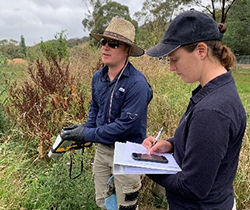
Soil sampling at Captains Flat
Captains Flat community engagement
Our staff have been meeting with the community of Captains Flat, near Queanbeyan in the state’s south, to talk about living with lead - a legacy of historic mining activity in the area. To keep the community informed we held two joint community drop-in sessions alongside the Department of Regional NSW, Department of Health and Local Land Services experts.
Our specialist technical staff have carried out precautionary testing of surface soils in public and community spaces in the small township to check for lead that has moved beyond the former nearby Lake George Mine, with all test results published on the EPA website. We also offered local residents an opportunity to have an EPA officer come to their home and test the soil in their backyard. This was taken up by many residents looking to understand more about lead in their environment.
Our message to the community is clear - don’t be alarmed but be aware that lead may be present in the soil and there are simple steps you can take to keep yourselves and your family living safely with lead.
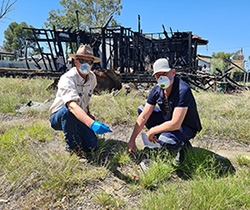
Inspecting Moree sites for asbestos
Helping NSW communities assess asbestos risk and safety
Moree Plains Shire Council in northern NSW requested help from the EPA to assess the risk of asbestos at 60 residential properties burnt out and abandoned in the town.
EPA Education Programs Manager Jillian Gallagher said residents are worried about the potential dangers of uncontained asbestos and the risk of injury especially to their children: “this worry places a heavy burden on their mental health and social welfare”.
A hazard and risk assessment methodology was trialled. The approach was based on frameworks developed and used to assess property damage after the 2019-20 bushfires. Property assessment reports were completed, and the team conducted ambient air monitoring.
The air monitoring showed no asbestos readings above health guideline levels.
Other NSW regional councils have expressed interest in participating with the EPA in similar assessments. The EPA coordinates all NSW Government agencies in managing asbestos as the lead on the NSW Asbestos Coordination Committee.
More information:
The NSW Asbestos Coordination Committee held its inaugural meeting in November 2020 https://www.asbestos.nsw.gov.au/nsw-asbestos-coordination-committee
Check out the new NSW asbestos website for information on asbestos and safety
Read more
https://www.asbestos.nsw.gov.au/nsw-asbestos-coordination-committee.
The EPA is holding Roadshow forums across NSW to inform council and industry representatives of the EPA’s key regulatory priorities and discuss local environmental topics. Read more
Narrabri gas multi-agency visit
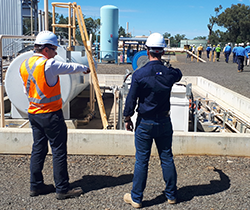
Several NSW agencies visited the Narrabri Gas Project in March
In mid-March gas company Santos briefed staff from multiple NSW Government agencies on the Narrabri Gas Project, which was approved to proceed by the NSW Independent Planning Commission in late 2020.
Several NSW Government agencies have a role in ensuring the gas project follows specific rules and guidelines within their approval to extract gas. The role of the EPA is to make sure the project is strictly regulated.
The first day involved inspections of existing Santos infrastructure and some areas that will be part of the phase 1 project, including the Leewood water storage and treatment facility, Bibblewindi compressor facility, Dewhurst 2 plugged and abandoned corehole, Narrabri East pilot site and the Narrabri East corehole site.
On the second day Santos provided a preliminary briefing for agencies on the expected range of management plans and the intended process for Santos to prepare and submit these plans to the Department of Planning, Industry and Environment (Planning and Assessment) and other agencies for review and comment.
The inspections were a good opportunity for the agencies to get an update from Santos and discuss the scope of works involved in the phase 1 program.
The multi-agency group included the EPA, NSW Resources Regulator, Biodiversity and Conservation, Department of Planning, Industry and Environment (Planning and Assessment), Forestry Corporation NSW and the NSW Rural Fire Service.
The EPA will be opening its 360 theatre to the community in Narrabri soon, the theatre showcases training modules in gas regulation and operations and will provide the community with increased understanding of the EPA’s role.
Bushfire Recovery Program in Clarence Valley
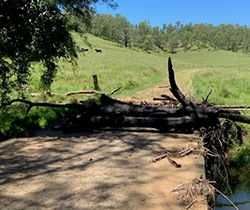
Northern NSW communities are being assisted with post bushfire clean-ups
We have embarked on a significant program to clean up waste from the bushfires on public land, as a next step in the NSW Government’s bushfire recovery program, following clean up and repairs in residential areas.
On ground assessments and consultation with the Baryulgil and Malabugilmah Aboriginal communities in the Clarence Valley in northern NSW, has helped to prioritise and assess clean-up for the two bushfire affected communities.
Restoration works in Baryulgil under the $200,000 grant include management of hazardous trees, maintenance and alignment of fencing and road grading, as well as improvement works to the Clarence River Cattle Dip. Works in Malabugilmah will total $90,000 and include removal of bushfire waste, the management and recycling of green waste and maintenance of fencing burnt in the bushfires.
EPA staff have been working with the Local Aboriginal Land Councils and Public Works Advisory in completing the works in as part of the $20 million Aboriginal Land Clean-Up Program.
EPA guides water use after sewage overflows at Stuarts Point
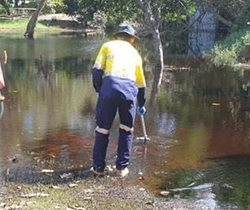
Water sampling after flooding at Stuarts Point
EPA Senior Operations Officer Josh Madden was deployed to the State’s Emergency Operations Centre in March to help with the flood response.
“One of the of the more interesting things I did was to sample septic-contaminated floodwater at Stuarts Point,” Josh said.
“Our team provided guidance to Fire and Rescue NSW and the local council on how to minimise the impact from dewatering the town.
“Dewatering means using a large pump to reduce the water level in the town’s water supply to help monitor for contamination.
“The threat to waterways from sewage run-off during severe rain events is one for small communities to be aware of.”
Learn more about what to do to mitigate risks from sewage overflows and other waste incidents during flooding in our top story on Flood response

